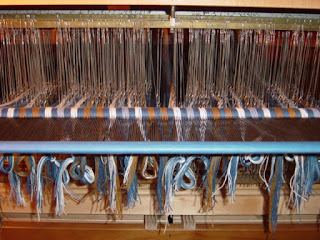Alrighty. I'm ready. Not only did I decide that warping back to front is the way to go but, I remembered to take pictures of the whole process to document. I encourage everyone out there who warps front to back to take a step out of the box and give this a try. I cut an hour and a half (and that's not even counting beaming!!!) off of my loom dressing time!!! Imagine that!!!
I am by no way claiming to have it all down pat as each of us has our own variations but, if you do see where I can improve.......please, I beg of you, let me know;) Here is my experience:
Step 1) Count out ends with a cross at only one end. Attach the ends to the back beam. If you have not yet done this before, simply remove the apron rod which you attach the warp and put it through the ends. Be careful to include the first and last thread on the apron rod so that they hold. Next attach the apron rod onto the apron. This step is a little easier if you have one apron rod already attached to the apron and tie on the second apron rod onto it. Slide the lease sticks through the cross and tie them together on each side about an inch apart.
Step 2) Tie the raddle onto the back beam and attach the lease sticks to the loom so they remain stationary. In this case they were suspended from the castle to the back beam. To prevent the threads from becoming tangled in the raddle place a folded piece of cardboard or heavy paper over the nails. Place the number of ends per inch in each space between the nails on the raddle. Ex:24 epi = 24 ends in each space between the nails. To prevent the threads from coming out of the raddle, place a rubber band over the nails. Bring the warp chains through to the front of the loom, through the harnesses (not the heddles) and over the front beam


Step 3) Wind the warp onto the back beam for about a yard. Go to the front of the loom and tug evenly on each chain warp then beam another yard. Repeat the process until there is about a yard to two feet left in front of the heddles.
Step 4) Untie the lease sticks and retie them to the castle, if one is available, so that they are on top of each other yet separated by about an inch. Remove the raddle being careful not to snag any of the threads.
Step 5) Raise the harnesses, if necessary, and suspend them using books or blocks. Position yourself comfortably in front of the loom, sitting if possible, and start threading the heddles. At this point the dressing process will be similar to threading front to back as you are simply threading the heddles. Tie them in bunches at each inch.

Step 6) Remove lease sticks and bring them through the harnesses so that they are resting on the front and back beams. You will be able, at this point, to rest the reed on them to draw through the ends. Center the reed and measure the distance to the starting point at draw through the ends. In this case the project is 24 epi with a 12 dent reed so, 2 ends per dent will be drawn through. Each inch is untied, drawn through the reed then retied.
Step 7) Place the reed back in the hand tree and secure. Tie the ends to the front apron rod. Viola!!!
If you have any questions or if any of these instructions are unclear, please contact me. We are planning on video tutorials early next year. Some of these will include continental knitting, warping back to front, and much more:)



Comments